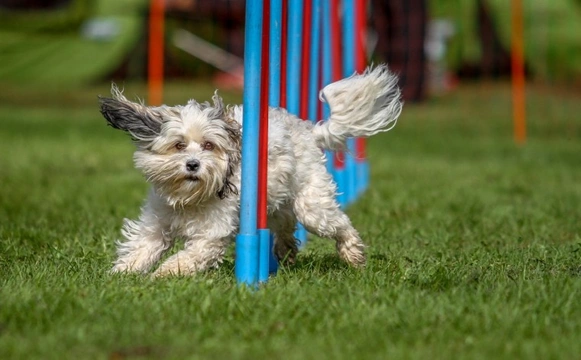
Can blind or partially sighted dogs take part in canine sports?
Canine sports are in many ways, a great equaliser for dogs. Unlike dog breed shows in which only eligible pedigree members of recognised dog breeds can compete, dogs of any breed or type can take part in competitive canine sports like agility, flyball and obedience, and often it is the mixed breeds and mongrels that really excel in these fields.
However, not all dogs are a good fit for canine sports and some may not even be able to have a go at all, for a variety of reasons. Some dog breeds just aren’t a good fit for canine sports at all due to factors that may include their size, conformation, intelligence or activity levels, such as breeds that are very heavy and stocky or that have particularly brachycephalic faces.
Additionally, a dog that is very old or young won’t benefit from taking part in canine sport, and this may even cause them harm, as is of course also the case for dogs that have certain types of health problems, disabilities or injuries.
All of this is just common sense if you think about it – but there are some grey areas where the answer to the question of whether or not any given dog can or should have a go at canine sports is less clear-cut.
One such instance is when it comes to dogs that are either blind or partially sighted, and vision problems do of course have a large and wide-reaching impact on the affected dog’s lifestyle and the type of care that they require in general. However, dogs that are blind or partially sighted can and usually do also enjoy happy, fulfilled and safe lives with the right accommodations made for them, and if this is the case, can they take part in canine sport?
In this article we will attempt to answer this very question. Read on to learn more.
Can blind dogs compete in canine sport?
As of the 3rd May 2019, the Kennel Club in the UK has made a formal statement on the use of blind dogs in canine sports.
The Kennel Club’s position is that it does not believe that it is in the best interests of dogs that are blind (completely blind) to take part in canine activities disciplines, and this includes virtually all forms of canine sport from heelwork to agility to field trials and working trials.
This decision was made after consideration by the Kennel Club’s Activities Committee Board in the best interests of the health and welfare of blind dogs, and states that completely blind dogs should not compete in any of the Kennel Club’s activities disciplines.
The reasons for this are multiple, and relate to the general care and welfare challenges faced by blind dogs. Blind dogs need to be able to orient themselves and move around without risk of harm; which when outside of the home means close supervision and direction by their owner, and being kept on a lead when outside of known enclosed areas that the dog is familiar with.
Even within the dog’s own home and garden, accommodations need to be made for a blind dog so that they can move around safely – which usually means things like not rearranging the furniture, keeping walkways clear, and avoiding doing things that might disorient or confuse the dog.
When you factor in a strange environment and for many canine sports, the deliberate use of obstacles, the ability of a blind dog to safely compete in an event and to be happy to do so is very limited.
Additionally, a totally new environment with lots of noise and fuss and of course, a lot of strange and often very excited other dogs around can be daunting for even a dog with perfect vision, and may be very stressful for a blind dog in particular.
Can partially sighted dogs compete in canine sports?
When it comes to partially sighted dogs and canine sports, the answer is less clear-cut. In the Kennel Club’s own statement on the use of blind dogs in canine sport, they make a very clear distinction within their policy that outlines its direct application to dogs that have no vision at all, and that it does not apply directly to dogs with partial vision.
Partial sight can be hugely variable; some such dogs might be able to see certain things in certain lights but be virtually blind in many situations, whilst others might have just a very minor vision problem that doesn’t really impact their day-to-day lives, or be able to see perfectly well from one eye but not the other.
The Kennel Club cautions would-be competitors to consider the welfare and happiness of their dogs at all times, and how their restricted vision may impact them in terms of their ability to see and interact with other dogs at competitions, as well as their ability to be able to see well enough to navigate the course or arena and any obstacles.
This is something that the owner of a partially sighted dog should consider very carefully – some partially sighted dogs will really enjoy canine sport and may do well at them, but it may not be in the best interests of others, and so this is something that you need to determine for your own dog on an individual basis.



